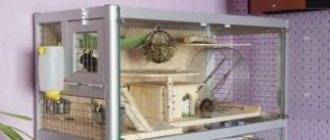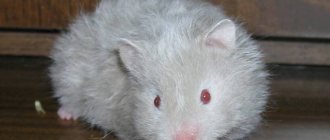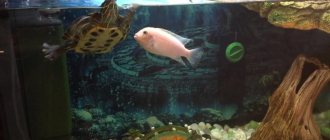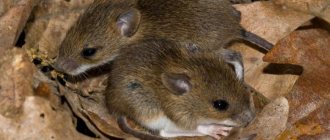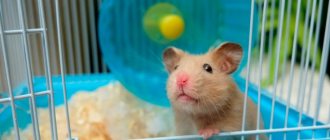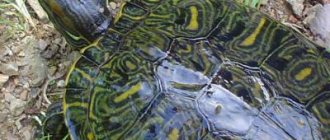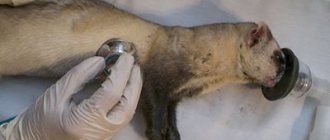The degu is a rodent native to South America. The animal is very active and friendly, has soft short fur, which is why it is loved by many people. He takes root well at home and quickly gets used to people. If you decide to get such a pet, information about it and our advice will definitely come in handy.
On a note! Degus are also called Chilean and bush squirrels.
Degu - TTX of squirrel (domestic squirrel)
The Chilean degu squirrel is an interesting and cute animal that can be kept at home. In appearance, it is a small squirrel with a short and dense neck, a round head, a flattened nose, and a slightly hunched back. The hind legs are several times longer than the front ones, and there is a beautiful tail with coarse fur.
The color of the squirrel is often gray-brown, with a light yellow or orange tint. The length of the squirrel including its tail is no more than 40 cm, and it weighs up to 280 grams. When kept at home, these indicators may change.
Chilean squirrels, unfortunately, are not long-lived; their lifespan is 4 years. If they follow all the rules of care and maintenance, they can live up to eight years in captivity. The main thing is to love and protect your pet from stress and injury.
The degu squirrel has an excellent sense of smell, hears sounds perfectly, but sees only at close range. A special sensory organ, vibrissae, helps it navigate in space and thereby avoid injury. Despite its agility and jumping ability, the degu squirrel can break its legs or dislocate them.
Reproduction
The mating season of the bush squirrel continues from late winter to mid-autumn. During one year, a rodent can produce offspring a maximum of two times. For squirrels living in captivity, the mating season is not tied to the seasons.
A female Degu can become pregnant again immediately after giving birth, but this can lead to the death of the squirrel or its offspring. Gestation of baby squirrels occurs over a period of three months.
Feeding with mother's milk, on average, 6 babies born, occurs over the course of four weeks. Parents also feed the squirrels with fresh vegetation.
Behavior
The behavior of degu squirrels when kept at home varies. They are cheerful, often even tame animals, but they are naturally shy and therefore behave warily, especially around people. There is no need to scare them with loud sounds, bright lights, grab them by the tail or sneak up from behind. A degu can jump up to 1 m in height and this is worth remembering, since if it is frightened, it can jump in the cage and get hurt.
Habitat territories
Degu squirrels living in burrows have chosen South America as their habitat. They prefer desert or rocky areas, but can live in swampy and wooded areas. They can also settle in floodplains.
Content
Once you have a squirrel at home, you should keep it in a cage. If it is spacious, the squirrel will be comfortable in it. You cannot let them run around the apartment, as they chew everything they come across - shoes, wallpaper, doors. They live in families, so they cannot stand loneliness, the only way out is to get them a mate or breed them. Sand baths are their weakness, and to do them you have to frequently clean around the cage and be prepared for sand to be everywhere.
House maintenance (cons)
- The squirrel gnaws everything it comes across;
- Cannot stand loneliness;
- Frequent colds;
- Sand baths;
- Compliance with diet;
- Cleaning the cage.
Life in nature
Degu squirrels live in families and usually there are 1-2 males, up to 6 females with 5-10 cubs. They build their burrows all together, reaching an area of up to 200 square meters. meters. When digging a home, they work harmoniously, forming a chain, and transfer earth to each other from the depths to the surface. Thus, they dig entire tunnels and live calmly, warmly, without fear of attack by birds of prey. They do not allow strangers into their territory and protect their space and even family members in every possible way.
Degus are very thrifty animals; there is always a supply of food in their home. Prepare for winter in advance.
A female can give birth twice in a year, but at home this happens more often. The mother feeds the cubs with milk for up to 6 weeks and makes sure that they do not leave the hole. If the cub escapes, the mother immediately returns it to the hole. Males actively participate in raising small squirrels, constantly monitor food, carry fresh grass and take care of them. They lead a daily lifestyle in normal life. They live in Peru, Argentina, Chile, where there are a lot of bushes and rocky terrain.
Is it worth getting a degu?
The Chilean squirrel is a rather unusual animal. This is not a hamster that feels comfortable sitting alone in a cage for days on end. They are very active and require a lot of attention. Before purchasing, you should study all the details of keeping a domestic squirrel and know what to prepare for.
Pros of keeping a degu at home
Degus have become favorite pets for many owners, because there are many advantages to keeping them.
- They eat quite a bit, so you won’t have to buy a lot of food, and for this reason they defecate less often, so the cage will have to be cleaned infrequently.
- They drink little, therefore, urinate less often, which also helps keep the cage clean for a long time.
- They are friendly, get used to being handled and are easy to train.
- They lead a diurnal lifestyle.
- Their life expectancy is quite long - 812 years.
To get a complete picture, you need to study the difficulties in keeping and raising this animal.
Cons of content
With all the advantages, there are also disadvantages.
- They are very active, love to move a lot, but at the same time you can’t let them roam freely around the house, they can chew on almost anything.
- They often suffer from colds, indigestion, may even develop diabetes, and are prone to allergies. Be prepared to care for a sick animal.
- They do not like loneliness and require attention, as in nature they live in packs. If you leave a degu alone for a long time, it can become unaccustomed to being handled and even go wild.
Important! In their natural environment, degus move long distances every day, so take care to organize activities for the animal.
Before you buy a degu
To ensure that the animal brings only positive emotions, and its life is comfortable for you, weigh the pros and cons before going to the pet store. Before buying an animal, be sure to answer whether you are ready:
- 7-12 years old to care for a pet?
- treat him and take him to the vet if necessary?
- devote time every day and train the animal?
- feed correctly?
- clean the cage in a timely manner?
- allocate additional funds for maintenance?
Ask yourself if you are ready to take full responsibility for the animal’s life. If the decision is balanced and informed, feel free to go shopping.
Feeding
The main rule when feeding degus is to follow a diet and exclude sweets and fats from the diet. Treats - cookies, fried nuts, food from the human table - all this should absolutely not be given to degus. Squirrels do not eat meat; they are vegetarians from birth; their food is fresh grass, plant roots and seeds. Now all this can be purchased at pet stores and some even in regular grocery stores. You should not overfeed the animal, it is better to give it portionwise - no more than 30% of the weight at a time, and so on 2-4 times a day.
Important! If you refuse food for more than a day, you should seek help from a doctor.
Rodent diet
An approximate daily diet for a degu squirrel is grain food with the addition of berries or herbs, a quarter of an apple, 3-4 pieces of carrots, 40-50 grams of white cabbage, 10 grams of muesli or raisins.
What can you feed
- Fruits (apple, banana, pear);
- Vegetables (cabbage, carrots, tomato, cucumber);
- Grains;
- Rusks;
- Dry peas;
- Hay (required, must always be available in the cage).
All products must be at room temperature and fresh.
What not to do
- Dairy products;
- Overripe and unripe vegetables and fruits;
- Homemade food;
- Fish, meat;
- Canned foods;
- I love any baked goods.
Be sure to install a sippy cup, preferably pour boiled or settled water, make sure that the water is not stained. Observe how the animal behaves after a snack; new foods should be introduced in small doses, even those purchased in a specialty store. Frequent scratching of the ears and other parts of the body is a possible sign of an allergic reaction.
Nuances of nutrition
The “menu” of the Degu squirrel consists of: all kinds of herbs, including medicinal ones; roots, leaves and flowers of shrubs; plants' seeds; vegetables and tree bark.
Since the squirrel is a herbivore, its diet should contain plant food daily, including hay, leaves and grass. Plant food is necessary for rodents to fully develop.
Housing
Particular attention should be paid to the squirrel’s home. The cage should be spacious - at least 70 cm in height, length and width. It is better to buy an iron cage, as the squirrel will quickly chew a plastic one. There must be a sufficient number of branches, roots and grains in it so that she can constantly gnaw on something.
Squirrels are very active, they need to constantly move, jump... so you can buy a wheel, usually they buy something that is suitable for chinchillas. It is not difficult to independently build small labyrinths and low stairs for active squirrels.
What should be in the cage:
- Hay;
- Sippy cup;
- Filler (wood, paper, pressed sawdust);
- Nest house;
- Wheel.
There is no need to place the squirrel’s home next to a radiator, window, or door. Let it be a quiet, inconspicuous corner where she will feel calm and comfortable, especially at first.
What should not be in a cage:
- A lot of toys;
- Glass;
- Dirt, garbage.
Origin of the species and description
Photo: Degu squirrel
Degu squirrels belong to chordate mammals, separated into the order of rodents, family Eight-toothed, genus Octodon, degu species. The historical homeland of the animal is Chile. In this regard, the squirrel was nicknamed Chilean. Today, a large number of populations of these animals live in natural conditions on the territory of Chile.
The first description of the animal was compiled by Juan Ignacio Molina. He was a priest and showed great interest in studying the life activities of representatives of local flora and fauna. He was a native of Chile and conducted many studies to describe the characteristics of various animals, including degu squirrels.
Video: Degu squirrel
In 1782, Juan Ignacio Molina published a book called An Essay on the Natural History of Chile. This book contains descriptions of many representatives of local flora and fauna, including the Chilean squirrel. Based on some external data and character traits, the researcher classified these animals as squirrels. In the book, he noted their sociability, love of games and mischief, and cheerfulness. He also wrote that some external signs allow us to conclude that the Chilean squirrel is a middle link between the dormouse and mice.
Indigenous people often called the animal Mapuche, which means “rat” in the Indian language. Today, animals are very common in various parts of the world as pets. Their breeders note that animals love attention and constantly demand large quantities of it. Among the advantages, they also name the animal’s unpretentiousness and undemandingness to living conditions and pliability to training.
How to tame
It is easier to tame an immature individual, since with age they are more timid towards humans and practically do not make contact. The main strategy is not to rush the squirrel and do not expect quick results.
Before starting your acquaintance, choose a suitable place where there are no wires or holes so that the squirrel simply does not run away from you. First, try speaking quietly to the degu, let the squirrel get used to your voice. The gentle and quiet voice will soon be recognizable to her. Try feeding the animal by hand; of course, don’t expect it to happen right away, everything should be done gradually. Hands should be washed well before feeding, and after too.
Important! Never pick up a squirrel from above; in nature, they are attacked by birds of prey in this way, so your pet can suddenly turn into an aggressive animal and begin to defend itself.
Advantages of keeping a rodent at home
Advantages of the Chilean squirrel as a pet:
Small dimensions. You don't need a lot of space for a degu. Modesty in nutrition. Decorative animals require less food and water than guinea pigs. High activity
Curious and energetic degus will not let you get bored and will become favorites of children who are careful when dealing with rodents. The biological rhythms of the pet and its owners will coincide.
Easy to learn
The animals quickly become attached to humans and are easy to train. Cleanliness and absence of unpleasant odor. Degus clean themselves and do not require special hygienic care from others. Due to the small volume of food and drink, the animals produce little excretion. Cleaning the cage is done quickly. Lifespan. This indicator for the South American guest is higher in comparison with hamsters, chinchillas and other relatives.
Attention! If degus have offspring, the animals will not need any additional care or equipment.
Diseases and prevention
The degu squirrel requires special attention to its health. The first signs of health problems are the eyes and teeth. If the teeth begin to turn white, then reconsider the pet’s diet; if spots appear on the eyes, the help of a veterinarian is required.
Frequent diseases of degus
- Conjunctivitis. This is a purulent and inflammatory process of the eyes, seek help from a veterinarian in this case for treatment;
- Cataract. More often this can be found in squirrels over the age of 6 years, a white spot on the brown background of the eye;
- Diabetes. This is perhaps the most common degu ailment. It manifests itself in the animal's lethargy, excess weight, and constant thirst. It cannot be cured, but can be avoided by following feeding recommendations;
- Colds. Degu does not tolerate temperature changes and drafts. Pay attention to the eyes - if they are watery, then the squirrel is sick. Also, mucus in the nose and apathy are signs of a cold. You can treat with a decoction of rose hips and calendula, but do not overdo it;
- Tumors. Especially in old age, this is associated with metabolic disorders.
How long do ferrets live at home?
Note that in the wild, domestic representatives of this species will not survive at all. Such animals are simply not adapted to exist in the steppe. How long do ferrets live at home? With proper care and a balanced diet, their life expectancy is 10 years. Although some representatives lived to be 15-18. This is how long domestic ferrets live. There are factors that can reduce the lifespan of an animal by five to six years. These include acquired or hereditary incurable diseases.
But we can say with confidence that keeping animals at home does not shorten the lifespan of animals. Now you know how long ferrets live at home. Of course, all the data given above are statistical averages. Therefore, a lot depends on conditions and nutrition.
We figured out how long a ferret lives. Now we need to highlight the main conditions for the long life of this beast. A lot here depends on nutrition. It should be as balanced as possible. You should always remember about the individual characteristics of your pet. When giving any new product, it is necessary to observe the animal’s reaction. Note that ferrets eat almost everything, but do not forget that they are predators. Therefore, the basis of the diet is meat. You can give these animals beef, offal, chicken, and horse meat. Some types of fish are also allowed, of course, without bones.
If you do not give your pet meat for a long time, then as a result his immunity will decrease, the digestive system will also be disrupted, and it is possible that his hair will fall out.
You can supplement your diet with special vitamin and mineral complexes. You should definitely consult a veterinarian about this. Of course, hygiene also affects the life expectancy of a pet. Ferrets love cleanliness and order. Their cage needs to be cleaned daily, rags and bedding changed. The home should always be warm and, of course, dry. Bowls and drinking bowls must be washed daily.
Getting offspring
Adults are considered to be degus that have reached one year of age. However, squirrels that are only 50 days old can begin the mating process. For this to happen, the animals must be on good terms with each other. If the owner wants his pet to produce offspring, he needs to take care of a suitable pair in advance. You need to purchase an individual of the opposite sex and place it with the animal that already lives at home.
You should carefully observe the behavior of the couple, because it is possible that the female and male may not get along with each other. In this case, one of them may show aggression towards their partner.
If the animals do not fight and treat each other favorably, offspring can be expected. It is recommended to remove objects from the cage that could injure the pregnant squirrel or the babies she gives birth to. These include shelves with food and a wheel.
Individuals close in blood are not suitable for mating, since the squirrels may be born weak and sick. The most suitable partners are those who are six months old. After birth, the male is placed in a separate cage. This is done to prevent re-mating. The female is ready to bear a fetus and give birth no more than once a year.
Pregnancy lasts for 90 days, after which the birth process occurs. Usually 5-6 babies are born, but sometimes their number reaches 12. There are times when only one baby squirrel is born. 4-6 weeks after receiving the offspring, the small rodents are moved: boys into one cage, girls into another. If this is not done, the young individuals will begin to mate.
Getting used to the cage
After acquiring a rodent, there is a natural desire to place it in a cage as soon as possible. It is not recommended to do this, since the animal needs some time to adapt to the surrounding reality. It is best to place the box in which the Chilean squirrel was transported next to the cage. Over time, when the animal gets used to the new environment and begins to behave more calmly, you can remove it from the carrier and place it in a cage.
It should be remembered that this must be done carefully so as not to cause unnecessary anxiety in the animal. Before this, it is recommended to place part of the bedding from the carrier in the place designated for the squirrel’s permanent residence. The degu will smell itself in the new place, which will help it cope with anxiety.
After the animal gets comfortable, it is necessary to walk it periodically. It should be allowed into a previously fenced off part of the room, freed from electrical wires, glassware and other objects that may attract the attention of degu squirrels. Some indoor plants can also pose a danger to these animals - anthurium, calla lilies, ivy, rhododendron, sansevieria, etc.
After a walk, the animal may not want to go back to the cage. In this case, you should place the structure next to it and open the door. The animal will soon come inside because it is either hungry or thirsty.
You can speed up this process by giving treats accompanied by soft whistling. The degu will remember this sound and will subsequently respond to it by running up to the feeder. If you have to catch the animal, you should under no circumstances cover it with your palm, otherwise the squirrel will be stressed. Do not grab the squirrel's tail to avoid damaging it.
Determining the sex of the animal
It is important to know how to determine the sex of cubs, since male and female degus are very similar in appearance. That is why it will be difficult to do this at first glance. Sex determination should begin by raising the tail and examining the area of the body where the anus is located. The cone-shaped appendage is mistaken by some for a penis, but it contains the urethra, which is present in both sexes. Boys' genitals are hidden inside the abdominal stripe and are not visible; in girls they are also invisible. Then how to determine gender if it is not possible to examine the genitals? This is done according to the distance between the anus and the appendix, which is practically absent in females, and approximately the length of the little finger in males.
If you know the characteristics of the behavior and reproduction of animals, then keeping them at home will not cause big problems. With proper care, degus are playful, cheerful and capable of responding to their owners with devotion and love.
Features of character and lifestyle
Photo: Degu squirrel
By nature, squirrels are endowed with excellent hearing and sense of smell, but their vision is rather weak. Such an acute sense of smell and hearing helps to detect the approach of possible enemies, and also serves as a landmark in the area and helps in the search for food. Squirrels are able to communicate with each other using various gestures, as well as through sound vibrations.
It is unusual for rodents to lead a solitary lifestyle. Under natural conditions, they live exclusively as part of a group. The size of such a group can vary: from 7 to 14 individuals. Several females occupy leading positions. All others obey permanent leaders.
Chilean squirrels are very nimble and nimble animals. They love to run and hide in shelters. A mandatory procedure in natural conditions is swimming in the sand. In this way, they manage to cleanse the body of excess moisture in the body and fat on the coat.
Interesting fact: Nature has endowed degu squirrels with an amazing ability for self-preservation. Predators often try to catch animals by their long tails. If they succeed, they peel back the skin of their tail, leaving it in the paws of the enemy. Small animals literally gnaw off the exposed part of the tail.
It has been scientifically proven that these animals simply physically need communication. If the breeder of an animal is not ready to devote a sufficient amount of time to it, you should think about getting some other animal. If a squirrel does not receive enough communication, it becomes aggressive and may bite. Also, animals' immunity decreases and they are prone to various diseases.
